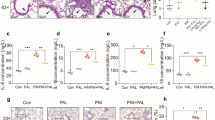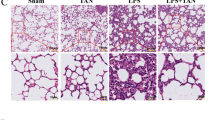Abstract
Dilong is an earthworm extract with a dense nutritional content, widely used in Chinese herbal medicine to remove stasis and stimulate wound healing. Earthworm extracts are traditionally used by indigenous people throughout the world. How this Dilong inhibits Lipopolysaccharide (LPS)-induced cardiomyoblast cell apoptosis is still unclear. This study investigates the Dilong extract effect on LPS-induced apoptosis in H9c2 cardiomyoblast cells. LPS (1 μg/ml) administration for 24 h induced apoptosis in H9c2 cells. Cell apoptosis was detected using MTT, LDH, TUNEL assay and JC-1 staining. Western blot analysis was used to detect pro-apoptotic and anti-apoptotic proteins. Dilong extract totally blocked the LPS impact, leading to the activation of anti-apoptotic proteins, Bcl-2 and Bcl-xL, stabilized the mitochondria membrane and down-regulated the extrinsic and intrinsic pro-apoptotic proteins, TNF-α, active caspase-8, t-Bid, Bax, active caspase-9 and active caspase-3. Dilong could potentially serve as a cardio protective agent against LPS-induced H9c2 cardiomyoblast cell apoptosis.







Similar content being viewed by others
References
Natanson, C., Esposito, C. J., & Banks, S. M. (1998). The sirens’ songs of confirmatory sepsis trials: Selection bias and sampling error. Critical Care Medicine, 26, 1927–1931.
Dombrovskiy, V. Y., Martin, A. A., Sunderram, J., & Paz, H. L. (2007). Rapid increase in hospitalization and mortality rates for severe sepsis in the United States: A trend analysis from 1993 to 2003. Critical Care Medicine, 35, 1244–1250.
Lu, Y. C., Yeh, W. C., & Ohashi, P. S. (2008). LPS/TLR4 signal transduction pathway. Cytokine, 42, 145–151.
Merx, M. W., & Weber, C. (2007). Sepsis and the heart. Circulation, 116, 793–802.
Hotchkiss, R. S., & Karl, I. E. (2003). The pathophysiology and treatment of sepsis. New England Journal of Medicine, 348, 138–150.
Stoll, L. L., Denning, G. M., & Weintraub, N. L. (2004). Potential role of endotoxin as a proinflammatory mediator of atherosclerosis. Arteriosclerosis, Thrombosis, and Vascular Biology, 24, 2227–2236.
Boyd, J. H., Mathur, S., Wang, Y., Bateman, R. M., & Walley, K. R. (2006). Toll-like receptor stimulation in cardiomyocytes decreases contractility and initiates an NF-kappaB dependent inflammatory response. Cardiovascular Research, 72, 384–393.
Yasuda, S., & Lew, W. Y. (1997). Lipopolysaccharide depresses cardiac contractility and beta-adrenergic contractile response by decreasing myofilament response to Ca2+ in cardiac myocytes. Circulation Research, 81, 1011–1020.
Meldrum, D. R. (1998). Tumor necrosis factor in the heart. American Journal of Physiology, 274, R577–R595.
van der Bruggen, T., Nijenhuis, S., van Raaij, E., Verhoef, J., & van Asbeck, B. S. (1999). Lipopolysaccharide-induced tumor necrosis factor alpha production by human monocytes involves the raf-1/MEK1-MEK2/ERK1-ERK2 pathway. Infection and Immunity, 67(8), 3824–3829.
van Empel, V. P., Bertrand, A. T., Hofstra, L., Crijns, H. J., Doevendans, P. A., & De Windt, L. J. (2005). Myocyte apoptosis in heart failure. Cardiovascular Research, 67, 21–29.
Kang, P. M., & Izumo, S. (2003). Apoptosis in heart: Basic mechanisms and implications in cardiovascular diseases. Trends in Molecular Medicine, 9, 177–182.
Haunstetter, A., & Izumo, S. (1998). Apoptosis: Basic mechanisms and implications for cardiovascular disease. Circulation Research, 82, 1111–1129.
Burlacu, A. (2003). Regulation of apoptosis by Bcl-2 family proteins. Journal of Cellular and Molecular Medicine, 7, 249–257.
Desagher, S., & Martinou, J. C. (2000). Mitochondria as the central control point of apoptosis. Trends in Cell Biology, 10, 369–377.
Zhang, Z. X., & Wang, F. F. (1992). Effects of crude extract of earthworm on promoting blood circulation to removing stasis. Zhongguo Zhong Xi Yi Jie He Za Zhi, 12(741–743), 710.
Grdisa, M., Popovic, M., & Hrzenjak, T. (2004). Stimulation of growth factor synthesis in skin wounds using tissue extract (G-90) from the earthworm Eissenia foetida. Cell Biochemistry and Function, 22, 373–378.
Tien, Y. C., Lin, J. Y., Lai, C. H., Kuo, C. H., Lin, W. Y., Tsai, C. H., et al. (2010). Carthamus tinctorius L. prevents LPS-induced TNFalpha signaling activation and cell apoptosis through JNK1/2-NFkappaB pathway inhibition in H9c2 cardiomyoblast cells. J Ethnopharmacol, 130, 505–513.
Sam, A. D, 2nd, Sharma, A. C., Law, W. R., & Ferguson, J. L. (1997). Splanchnic vascular control during sepsis and endotoxemia. Front Bioscience, 2, e72–e92.
Parrillo, J. E., Parker, M. M., Natanson, C., Suffredini, A. F., Danner, R. L., Cunnion, R. E., et al. (1990). Septic shock in humans. Advances in the understanding of pathogenesis, cardiovascular dysfunction, and therapy. Annals of Internal Medicine, 113, 227–242.
Chopra, M., & Sharma, A. C. (2007). Distinct cardiodynamic and molecular characteristics during early and late stages of sepsis-induced myocardial dysfunction. Life Sciences, 81, 306–316.
Ren, J., Ren, B. H., & Sharma, A. C. (2002). Sepsis-induced depressed contractile function of isolated ventricular myocytes is due to altered calcium transient properties. Shock, 18, 285–288.
Gupta, A., Brahmbhatt, S., Kapoor, R., Loken, L., & Sharma, A. C. (2005). Chronic peritoneal sepsis: Myocardial dysfunction, endothelin and signaling mechanisms. Front Biosci, 10, 3183–3205.
Niebauer, J., Volk, H. D., Kemp, M., Dominguez, M., Schumann, R. R., Rauchhaus, M., et al. (1999). Endotoxin and immune activation in chronic heart failure: A prospective cohort study. The Lancet, 353, 1838–1842.
Patten, M., Stube, S., Thoma, B., & Wieland, T. (2003). Interleukin-1beta mediates endotoxin- and tumor necrosis factor alpha-induced RGS16 protein expression in cultured cardiac myocytes. Naunyn Schmiedebergs Arch Pharmacological, 368, 360–365.
O’Dwyer, S. T., Michie, H. R., Ziegler, T. R., Revhaug, A., Smith, R. J., & Wilmore, D. W. (1988). A single dose of endotoxin increases intestinal permeability in healthy humans. Archives of Surgery, 123, 1459–1464.
Salzman, A. L., Wang, H., Wollert, P. S., Vandermeer, T. J., Compton, C. C., Denenberg, A. G., et al. (1994). Endotoxin-induced ileal mucosal hyperpermeability in pigs: Role of tissue acidosis. American Journal of Physiology, 266, G633–G646.
Liu, C. J., Lo, J. F., Kuo, C. H., Chu, C. H., Chen, L. M., Tsai, F. J., et al. (2009). Akt mediates 17beta-estradiol and/or estrogen receptor-alpha inhibition of LPS-induced tumor necresis factor-alpha expression and myocardial cell apoptosis by suppressing the JNK1/2-NFkappaB pathway. Journal of Cellular and Molecular Medicine, 13, 3655–3667.
Chang, G., Zhang, D., Liu, J., Zhang, P., Ye, L., Lu, K., et al. (2014). Exenatide protects against hypoxia/reoxygenation-induced apoptosis by improving mitochondrial function in H9c2 cells. Experimental Biology and Medicine, 239(4), 414–422.
Acknowledgments
This study is supported by the Taiwan Department of Health Clinical Trial and Research Center for Excellence (DOH102-TD-B-111-004) and in part by (CMU99-EW-05, CMU102-BC-6) China Medical University.
Author information
Authors and Affiliations
Corresponding author
Rights and permissions
About this article
Cite this article
Li, PC., Tien, YC., Day, C.H. et al. Impact of LPS-Induced Cardiomyoblast Cell Apoptosis Inhibited by Earthworm Extracts. Cardiovasc Toxicol 15, 172–179 (2015). https://doi.org/10.1007/s12012-014-9281-z
Published:
Issue Date:
DOI: https://doi.org/10.1007/s12012-014-9281-z




